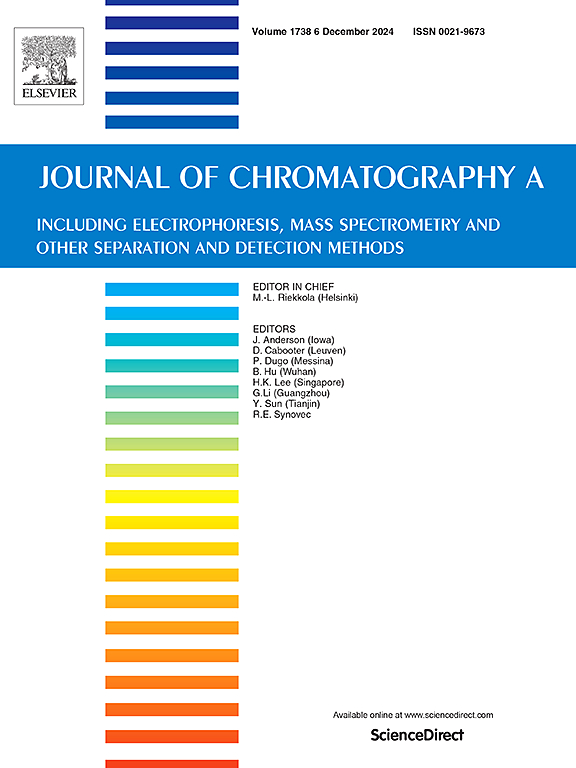核-壳磁性金属-有机骨架在分散微固相萃取-分散液-液微萃取联合提取富集橙花、雪铁兰、茴香中草药浸剂中部分农药中的应用
IF 3.8
2区 化学
Q1 BIOCHEMICAL RESEARCH METHODS
引用次数: 0
摘要
本文介绍了一种利用核壳磁吸附剂(即Cu-BTC@Fe3O4)从中药注射剂中提取农药的创新技术,该技术通过与分散液液微萃取法耦合,实现了目标农药的显著富集系数。为了验证吸附剂的成功合成,使用了一系列的分析技术,包括振动样品磁强计、扫描电子显微镜、透射电子显微镜、傅里叶变换红外光谱、x射线衍射、能量色散x射线和布鲁诺尔-埃米特-泰勒分析。在萃取过程中,采用涡旋搅拌和外加磁场分别帮助分析物解吸和吸附剂分离。此外,异丙醇和去离子水的混合物用于从吸附剂表面解吸分析物。用1,2-二溴乙烷作为萃取溶剂,将得到的含有解吸农药的上清液混合后注入到水介质中。离心后,取1 μL的沉淀相加入配备火焰电离检测器的气相色谱系统中。方法的相对标准偏差(1.0 ~ 8.5%)、可接受的提取回收率(39 ~ 93%)、富集系数(195 ~ 475)、校准曲线线性(r2=0.993 ~ 0.998)、定量限(0.34 ~ 3.0 μ L-1)和检测限(1.1 ~ 9.9 μ L-1)均较低,验证了方法的可靠性。没有基质效应,实际样品的相对回收率为80- 120%,吸附剂和提取溶剂的使用最少,由于消除了两个离心步骤(由外部磁场促进)而减少了提取时间,以及使用环保溶剂,这些都突出了该方法的优势和重要价值。本文章由计算机程序翻译,如有差异,请以英文原文为准。
Application of core-shell magnetic metal-organic framework in developing dispersive micro solid phase extraction combined with dispersive liquid-liquid microextraction for the extraction and enrichment of some pesticides in orange blossom, Aloysia Citrodora, and fennel herbal infusions
This paper introduces an innovative technique for extracting pesticides from herbal infusions using a core-shell magnetic adsorbent (i.e., Cu-BTC@Fe3O4) where achieving a notable enrichment factor for the target pesticides by coupling with a dispersive liquid-liquid microextraction method. To validate the successful synthesis of the adsorbent, a range of analytical techniques were utilized including vibrating sample magnetometer, scanning electron microscopy, transmission electron microscopy, Fourier transform infrared spectroscopy, X-ray diffraction, energy dispersive X-ray, and Brunauer-Emmett-Teller analyses. A vortex agitation and an external magnetic field were used during the extraction process to aid the analytes' desorption and adsorbent separation, respectively. Also, a mixture of iso-propanol and deionized water was used to desorb the analytes from the adsorbent surface. The resulting supernatant containing the desorbed pesticides was mixed with 1,2-dibromoethane as the extraction solvent and then injected into an aqueous medium. After centrifugation, 1 μL of the sedimented phase was introduced into the gas chromatograph system equipped with a flame ionization detector. The reliability of the proposed methodology was confirmed by obtaining low relative standard deviations (1.0–8.5 %), acceptable extraction recoveries (39–93 %), substantial enrichment factors (195–475), calibration curve linearity (r2=0.993–0.998), and significantly low limits of quantification (0.34–3.0 μg L−1) and detection (1.1–9.9 μg L−1). Absence of matrix effects with relative recovery values of 80–120 % for real samples, minimal use of the adsorbent and extraction solvent, a reduction in extraction time due to the elimination of two centrifugation steps (facilitated by an external magnetic field), and the use of environmentally friendly solvents collectively highlight the advantages and significant values of this approach.
求助全文
通过发布文献求助,成功后即可免费获取论文全文。
去求助
来源期刊

Journal of Chromatography A
化学-分析化学
CiteScore
7.90
自引率
14.60%
发文量
742
审稿时长
45 days
期刊介绍:
The Journal of Chromatography A provides a forum for the publication of original research and critical reviews on all aspects of fundamental and applied separation science. The scope of the journal includes chromatography and related techniques, electromigration techniques (e.g. electrophoresis, electrochromatography), hyphenated and other multi-dimensional techniques, sample preparation, and detection methods such as mass spectrometry. Contributions consist mainly of research papers dealing with the theory of separation methods, instrumental developments and analytical and preparative applications of general interest.
 求助内容:
求助内容: 应助结果提醒方式:
应助结果提醒方式:


